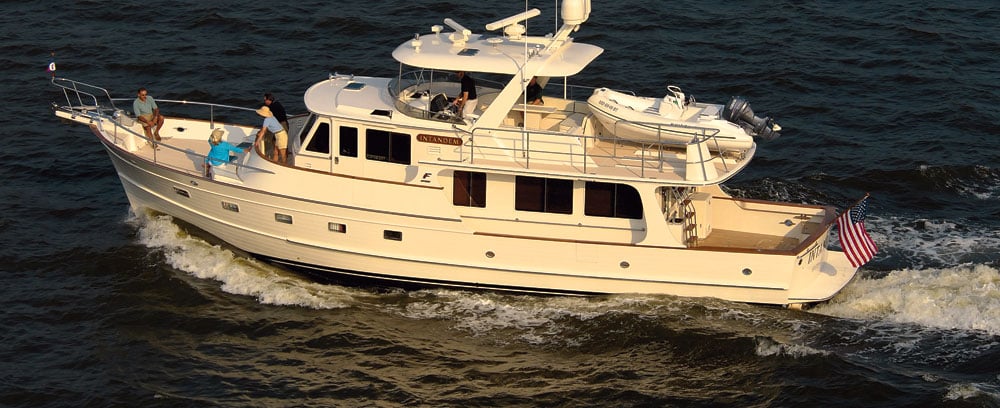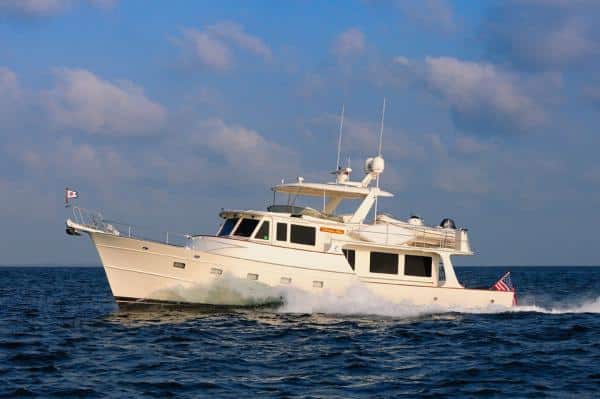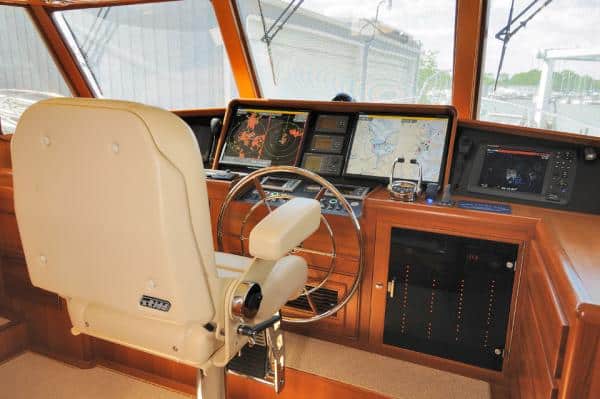
Fleming 55
In my lifetime, a small handful of production boats have become true classics, if not legends. The Bertram 31, Grand Banks 42, Hinckley Bermuda 40 and Hatteras 53 come to mind and are examples of designs that enjoyed lengthy, successful production runs. Long after they were discontinued, they have remained popular on the brokerage market, sometimes commanding premium prices.
Among these recent classics, one model remains in production today. Hull No. 212 of the Fleming 55 was delivered in April 2011, and a number of new 55s are in production at Fleming‘s yard in Taiwan (see the gallery with detail photos here). First launched in 1985, the Fleming 55 owes its longevity not only to its successful design, but also to the company’s commitment to making improvements to each hull it builds.
Duncan Cowie and Adi Shard, the talented Brits who have taken over the management of the company from its founder, Tony Fleming, say each new Fleming 55 incorporates eight to 10 improvements over the previous hull. Based on building an average of 10 55s per year, the math equates to 400 to 500 changes over just a five-year period.

Keeping this classic up to date is largely the result of the relationship among the factory, Fleming’s dealers and its owners. Chuck Hovey Yachts on the West Coast and Burr Yacht Sales on the East Coast have been Fleming’s only dealers in the United States since the brand’s earliest days. Along with Fleming’s select dealers in Canada and Europe, they have a valuable, historical understanding of the product. “I can’t remember how many times a customer has asked ‘What if we did this?’” comments Ray Currey of Burr Yacht Sales. “Some of these suggestions make very good sense, and we pass them along to the factory to be considered for future production.”
While Fleming embraces new ideas and technology, the company is quick to point out that it makes changes only after thorough research and sea trials, as opposed to catering to whims and fancies. For example, the 55’s centerline hallway leading to three staterooms and two heads all on one level is a hallmark of Fleming’s design. This arrangement eliminates steep, hard-to-negotiate stairways needed to accommodate a midships master stateroom — a feature that may seem attractive but which creates unintended design consequences. Also sacred to Fleming’s design is its dedicated pilothouse, which is three steps up from the ship’s living area. Because one does not pass through the pilothouse to the staterooms or heads below, the ship’s operation is undisturbed while guests freely enjoy the yacht’s living and sleeping areas.
Likewise, the Fleming’s semidisplacement hull design, with its sharp entry, rounded bilge sections forward, hard chines aft and moderate deadrise, has proven itself to be comfortable, seaworthy and efficient throughout its cruising-speed range of 8 to 18 knots. With so many Fleming 55s safely cruising throughout the world, the company knows it has a winner and has not changed its basic hull design
Likewise, most of Fleming’s owners use their yachts the way Tony Fleming originally intended — for coastal and offshore cruising. The company keeps an open line of communication with its owners, who are only too happy to share their personal tips and tricks, the best of which have been incorporated into production. And last but not least, Tony Fleming continues to cruise the world’s oceans on his personal Fleming, vigorously testing new ideas and equipment. (See more of these adventures here.)

The complexity of today’s Fleming 55 is a far cry from when Tony Fleming launched his first hull. To ensure that its boats comply with all current safety and construction standards, as well as federal regulations, Fleming has taken a major step forward in having its new boats certified by the National Marine Manufacturers Association (NMMA).
The NMMA certification process was no casual undertaking; it required rigorous inspections of the company’s facility in Taiwan as well as finished boats located in Maryland and Vancouver, British Columbia. In addition, all Fleming models will now be inspected on an annual basis. NMMA-certified boats must also meet the stringent standards of ABYC (American Boat & Yacht Council), as well as comply with Environmental Protection Agency requirements for emissions and wastewater systems.
While all boats sold in the United States must meet U.S. Coast Guard minimum regulations, NMMA-certified boats, like the Fleming 55, benefit from this vigorous, third-party inspection program.
Tony Fleming must have known from the beginning that he had a winner in his Fleming 55. But only through a consistent program of upgrading, improving and refining the original has it reached its current status of a thoroughly modern living legend.
Fleming Yachts, 949-645-1024; www.flemingyachts.com








